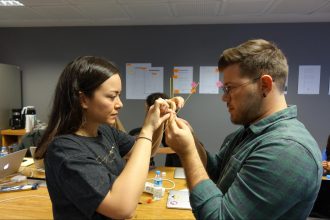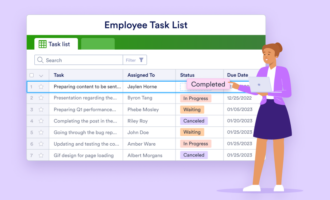You’ve probably heard thought leaders and business buffs cite workplace collaboration as the key to business success. But what exactly is workplace collaboration? How is it defined? It’s more than just teamwork and group projects or working together in a “you do this; I’ll do that” fashion.
What is workplace collaboration?
True workplace collaboration is the power of collective intelligence and knowledge building — the magic that happens in the spaces between people. It’s about layering and linking individual ideas and contributions to achieve more together than anyone could achieve alone.
With effective workplace collaboration, your employees will be more fulfilled, creative, and productive, empowering them to produce better results faster.
The problem is, while it may be easy enough to assemble teams, true collaboration isn’t that simple. Poor leadership, conflicting agendas, subpar communication, and self-interest are just a few of the challenges that hinder collective projects.
Fortunately, with the right tactics and tools, anyone can foster productive collaboration in the workplace and enjoy its many benefits.
In this guide, we’ll explore why workplace collaboration is important as well as specific ways to improve it — including key methods and software to adopt as organizations continue to embrace remote work and geographically dispersed labor forces.
Why collaboration is important
To fully grasp the value of collaboration, it’s important to first distinguish the term from cooperation. While the two concepts are often used interchangeably, they are, in fact, fundamentally different, and the distinction has real implications for how work is done.
Collaboration vs cooperation: What’s the difference?
Broadly speaking, cooperation involves individuals or teams assisting and supporting one another — typically through knowledge and information sharing — in pursuit of related but sometimes distinct interests. Cooperating groups may divide tasks among themselves and work independently on their own portion of the puzzle.
Collaboration, on the other hand, involves working together in an active and interdependent way to construct new knowledge and solutions and achieve a vision that’s shared by all.
When it comes to workplace cooperation, the focus is often on individual goals, interests, and contributions. Collaboration is all about common goals, pooled resources, and joint decision-making. Cooperation is more connective — it’s “me” helping “you” achieve your goal (and vice versa) — while collaboration is more collective — it’s “us” working together in support of our vision.
In short, for successful workplace collaboration, employees need to work together toward a shared goal, communicate frequently, play off each other’s tacit knowledge, skills, and ideas, and, most importantly, create real value in the form of new products, processes, and ways of thinking.
The importance of workplace collaboration
The old adage “two heads are better than one” captures why collaboration has the power to add significant value to all facets of our lives. Multiple “heads” bring together multiple ideas, distinct perspectives, varying areas of expertise, wider cultural understanding, and access to multiple resource pools, ultimately creating more comprehensive solutions with the potential for far-reaching impact.
While collaboration is important in personal relationships, it’s probably most widely recognized as being critical for success in the business world. (In fact, nearly 75 percent of employers rate collaboration as “very important.”)
Why exactly is collaboration so prolific in the workplace today? Globalization and advancements in technology both play a role. But much of collaboration’s increasing importance has to do with the growing complexity of work and the associated specialization of knowledge and skills.
Today, many of us are specialists in our fields — we know a huge amount about a narrow subject area. So in order to execute a whole project that has multiple moving parts, we have to work closely with other experts across functional and departmental boundaries.
Think about a UX designer, for instance, trying to get an app off the ground without having regular exchanges with a developer. Or an animator trying to produce an explainer video without having first created a narrative with a copywriter.
In today’s knowledge economy, a business’s most precious asset is the information in employees’ heads. To capitalize on this, you must connect people physically or digitally to share insights and best practices. Collaboration is how individuals quickly and easily access the knowledge and resources they need to expand their thinking and produce quality work.
A collaborative approach pays off for both companies and individual employees. Time and again, studies have shown that collaboration has the power to improve problem-solving, nurture creativity, enhance execution, increase productivity, boost organizational agility, and foster a sense of belonging and well-being among workers. This type of synergy often results in increased profitability.
It’s no surprise, then, that many successful businesses — those that have achieved phenomenal revenue growth while generating real value for their target audiences — prioritize workplace collaboration. Here are a few examples.
3 examples of collaboration in business
1. Pixar
The world-renowned computer animation company eliminates boundaries between departments to facilitate collaboration that fosters next-level creativity. The studio has an “anyone can talk to anyone” policy and a “creative brain trust” that employees can draw on for collective problem-solving.
Its headquarters is also designed with bathrooms, meeting rooms, mailboxes, and a cafeteria at the center to encourage chance encounters between staff from different disciplines that might just lead to the next big breakthrough.
2. UCB
This global biopharmaceutical company, which now operates in almost 40 countries, involves patients (its end users) in cross-functional working groups to get the 360-degree input needed to create effective new treatments. The business even launched a research and development-focused online collaboration platform so it can work closely with customers to innovate in the medical space.
3. The Motley Fool
One of few companies in the world to have a chief collaboration officer, this multimedia financial services enterprise encourages joint idea generation and problem-solving in the workplace through initiatives like in-house games and quizzes as well as desks on wheels that can be easily pushed together for project groups.
As a result of its collaborative push, the company has reported increased productivity and employee satisfaction, as well as lower turnover and reduced costs.
6 major benefits of collaboration in the workplace
Along with being fundamentally important for business performance, workplace collaboration also has a number of specific benefits for both organizations and employees:
1. Increased motivation, engagement, and productivity
Research has shown that just the sense of working collaboratively with others, even if physically apart, can prompt people to persevere longer on a difficult task, develop more interest in the activity, and feel less fatigued as they work on it. Workplace collaboration also boosts intrinsic motivation and encourages individuals to embrace new challenges.
These findings make sense. When working together as a cohesive group, people encourage and energize each other. They spur each other on and help one another remain focused and engaged.
Individual employees also win. As anyone can attest, feeling more driven and productive at work makes it that much easier to get up in the morning and head to the office.
2. More creative products and services
If iteratively building on each other’s ideas is a key element of workplace collaboration, then it follows that groups working closely together will eventually come up with something novel, if not revolutionary.
Again and again, we’ve seen that collaboration underpins innovation. By bringing together diverse, and sometimes competing, views and perspectives, collective efforts help spark creative magic. Collaboration encourages employees to change their way of thinking, transform processes, and as a result, generate original ideas that work.
3. Greater efficiency and time savings
People work as much as 25 percent faster when they operate collaboratively. Thanks in part to more seamless communication, employees don’t have to waste time searching for the information they need to tackle tasks; it’s all at their fingertips. They can access resources, attain knowledge, and make decisions faster simply by consulting the people they’re working with.
A cohesive, aligned approach also reduces the need for constant back and forth and minimizes time lost to misunderstandings because everyone is on the same page.
Improved efficiency naturally leads to cost savings for organizations — time is money, after all. And it means that solutions can go to market more swiftly — ahead of competitors’, which any entrepreneur knows is critical for success.
4. Employee growth and professional development
When individuals collaborate, they learn from one another. They develop cross-functional skill sets and discover alternative methods of working. By navigating differences in values and perceptions, they also hone their ability to think critically, solve problems, and engage in constructive debate.
For these reasons, collaboration at work can play a beneficial role in employees’ professional development. As staff members learn and grow, they don’t just enjoy the personal advantage of advancing in their careers; they also bring more to their current roles and add more value to the company.
Millennials and Gen Z, in particular, are drawn to organizations that provide development opportunities — including those that offer the chance to work closely with mentors and leaders. Cultivating a collaborative work environment could help attract talent from these generations, which now make up a big chunk of the workforce.
5. Higher quality output
Collaboration within organizations doesn’t just lead to more innovative ideas but also higher quality work — especially in the healthcare and education industries.
This is because collective efforts draw on the unique strengths of many individuals, rather than just one. Collaboration also ensures that individual biases don’t damage output and that risky, novel ideas are balanced by safer, more conventional ones to arrive at the best possible solution.
6. Enhanced job satisfaction
If you’ve ever had the experience of being part of something bigger than yourself — a team sport, for example — you know it can be very rewarding. The resulting sense of belonging and camaraderie naturally makes us happier.
That’s why improved employee satisfaction and well-being is one of the major benefits of collaboration in the workplace. Individuals who feel connected and involved in bigger picture projects have higher morale and are more content in their jobs.
And of course, when employees are happier, they’re more likely to stick around. Organizations then face lower turnover and don’t have to constantly pour time and money into recruiting and training new staff.
How to improve workplace collaboration
A collaborative team is only as strong as its individual members, all of whom have their own personal experience and knowledge. Providing team members with strong guidelines for communicating, problem-solving, and creative thinking can unlock the potential for great collaboration.
Important skills for effective collaboration
While it’s clear that collaborating effectively allows teams to do their best work together, the challenge of great collaboration is that it doesn’t come naturally to everyone. To become exceptional at it, both individuals and organizations need to cultivate and improve certain skills.
Working with others on a sustained, long-term basis requires a mix of interpersonal skills. To help the group work toward a common goal, members need to communicate and solve problems. Coordination and knowledge sharing are also key.
With great collaborative skills come huge benefits. A strong sense of team identity, better workplace morale, higher levels of innovation and creativity, and increased productivity are all possible outcomes.
How can your organization reap the rewards of successful workplace collaboration? Consider helping collaborators do the following:
- Be honest and trustworthy. Mutual trust between team members strengthens communication. When a team is confident that everyone is dealing above board, with integrity, they will approach each other from a place of goodwill. This confidence in the good intentions of your partners is essential to resolving creative differences when they inevitably arise. Some rules for cultivating trust: Give partners the benefit of the doubt, don’t talk behind a teammate’s back, and avoid conflicts of interest.
- Listen. To effectively listen, you have to try to understand a speaker’s perspective without judging, being distracted, or interrupting. This means that instead of thinking about what you’re going to say next while someone is speaking, make sure you hear all they have to say. In many ways, active listening is about understanding concepts at a deeper level than what’s being expressed — making connections between what you’re hearing and the thought behind the words. A really good listener can hear different ideas and forge them into workable solutions.
- Remain open to learning. No one person can come up with every good idea. Keeping an open mind releases you from the trap of only trusting your own perspective or solely doing what’s been done before. Your team spirit relies on openness — it allows you to learn and enables team members to trust and learn from you. Remaining open also means understanding your limits, your strengths and weaknesses, and how you can improve. Recognize that every team member brings something different to the table. This is the meaning of collaboration: Different perspectives power creativity and innovation. It’s important to understand these differences and appreciate them while evaluating new concepts and ideas on their own merit.
- Designate roles and responsibilities. Since everyone on the team has a specific set of skills, it makes sense that those skills be put to use to make the team stronger. Roles and tasks should be doled out to the team members best suited for them. It’s a good idea to identify team members’ roles early and review them during the course of the project. The expectations for each team member should always be related to the team’s overall purpose. During the course of the collaboration, a team member’s special skills may be less in need. Their responsibilities could shift to accommodate the team’s new focus.
- Stay focused on the common goal. To see the big picture, always keep an eye on the common goal. This helps every team member keep track of their individual responsibilities and how their piece of the work fits into the whole. Staying on top of the common goal helps keep everyone accountable. Since it’s always possible for a workplace collaboration to go off track, it’s important to be vigilant. Having regular team meetings is great, but be sure to occasionally evaluate their effectiveness. Each team member should have performance goals that emphasize teamwork and results.
When it comes to creating the perfect collaborative environment, there’s one rule above all others: Communicate. When a team is able to ask clear questions and give clear answers, they will collaborate well.
Improving collaboration with Jotform Teams
Effective collaboration means that all team members can stay in touch whenever they need to. That’s why it’s essential to have the right software.
With Jotform Teams, you can
- Create, edit, and share forms, tables, apps, reports, and more from one secure, centralized workspace
- Collect feedback from clients, employees, and vendors to improve products and the overall customer experience
- Streamline your approval process with workflow automation to minimize backlogs and keep everyone on the same page
- Integrate with popular third-party apps — including customer relationship management (CRM) systems Salesforce and HubSpot, email marketing tools Mailchimp and ActiveCampaign, and payment processors Square and PayPal — to share data and information across multiple channels
- Assign user roles and create folders to manage tasks and projects more efficiently
- Sign and share digital documents on any device
- Track and manage team progress with an activity log to increase visibility and accountability
Not only is this powerful solution easy to set up, but it’s also completely code free, helping team members of all programming backgrounds collaborate effectively and efficiently.
Now that you have a good idea of what makes a collaboration team tick, it’s time to turn your knowledge into action. Just remember the essentials of workplace collaboration: honesty, openness, effective listening, communication, and dynamic software.
Focus on the common goal of the group, and be sure to keep track of roles and responsibilities throughout the life of the project. In the end, you’ll find the sweet spot to successful workplace collaboration and, ultimately, growth and scalability.




























Send Comment: